In Lydia Gonzalez’ house on Fort Worth’s old South Side, leaky pipes rotted the floor under her bathtub, and the whole bathroom had to be ripped out and redone.
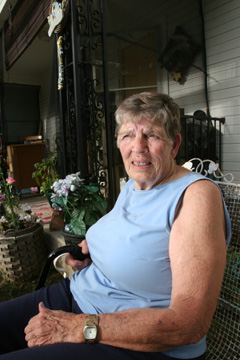 Up the street, the shingles on Ruby Walker’s roof will likely blow off if hit by one strong windstorm. Rayvonne Price’s house on the far Southeast Side has foundation cracks and leaky plumbing. Across town, the house at 3212 Prairie St. sits empty, its yard overgrown with weeds. The one couple who lived there for a few months had originally refused to accept the deed because the house was so poorly built and had so many problems. And on Eastcrest Court, in Stop Six, four new houses on one block have been sitting empty for almost two years, the owner unable to find buyers, even in a neighborhood where decent housing is at a premium. The problems with all these houses — and dozens more like them, scattered in low-income neighborhoods around Fort Worth — aren’t due to age or years of poor maintenance.
Up the street, the shingles on Ruby Walker’s roof will likely blow off if hit by one strong windstorm. Rayvonne Price’s house on the far Southeast Side has foundation cracks and leaky plumbing. Across town, the house at 3212 Prairie St. sits empty, its yard overgrown with weeds. The one couple who lived there for a few months had originally refused to accept the deed because the house was so poorly built and had so many problems. And on Eastcrest Court, in Stop Six, four new houses on one block have been sitting empty for almost two years, the owner unable to find buyers, even in a neighborhood where decent housing is at a premium. The problems with all these houses — and dozens more like them, scattered in low-income neighborhoods around Fort Worth — aren’t due to age or years of poor maintenance.
In fact, most of those described have been built within the last six years. Owners, tenants, and neighbors have had a hard time getting the city to do anything about them. Maybe that’s because a city-owned non-profit housing financing corporation built or renovated most of the houses and provided the seed money for others. City employees inspected and passed the work. And it’s the city that has failed, in violation of its own codes and ordinances, to see that the houses were built properly and the yards of its properties kept mowed and weed-free. Work on the houses was paid for in full by federal funds that the city is charged with administering — intended to provide much-needed decent housing for the poor and near-poor, while also spurring further recovery of ailing neighborhoods. But in case after case, neighborhood after neighborhood, according to residents, city leaders, and housing activists, the city has fallen far short of both goals — in many cases contributing to the blight rather than helping to turn it around. Locals aren’t the only ones raising questions about how the city is spending all those millions in federal low-income housing dollars.
In a critical report released this week, the U.S. Department of Housing and Urban Development noted that the city has repeatedly botched new construction and home repair projects — so badly that HUD wants the city to repay from its general fund about $600,000 spent on projects that have now gone belly-up. Repair work and lead-paint abatement on some houses was found to be so deficient that HUD has ordered the housing department to re-inspect all of the homes it renovated in the past two years. And that’s on top of another critical HUD review, released a few weeks ago, putting the city on notice that it may have to repay as much as $1.45 million that was ill-spent on major inner-city revitalization efforts. It’s a serious problem in a town that, according to its own 2005 strategic planning report, faces major housing deficiencies for the growing number of poor and low- to moderate-income families — groups that, together, make up almost 66 percent of the city’s population, according to census, U.S. Department of Labor, and regional data. The report, prepared for HUD to determine the city’s housing needs through 2010, also notes that most of the city’s poor and moderate-income families are concentrated in aging and deteriorating central-city neighborhoods where the housing stock is low in quantity and much of it is boarded up or condemned.
Critics of the city’s low-income housing program — including former city council members and former housing department employees — blame the failures on a rogue housing department that, with little or no oversight from the city council, has abandoned its mission of providing quality housing for the inner-city working poor. Instead, they charge, the department is pandering to favored developers, wasting large sums of money on projects that go nowhere, and spending federal dollars carelessly and with little accountability. An independent inspector hired by Fort Worth Weekly found, in just one house, serious deficiencies that included safety problems, violations of federal standards, and installation work that violated the city’s own building codes. Jerome Walker, who has led the housing department for the last 12 years, said his critics are wrong. He acknowledged in an interview in May that some of the houses built for the poor here have not always been “of stellar quality.” But Walker said that he and his staff are committed to building quality homes in poor neighborhoods. “I’m “proud of our work,” he said. He did not return calls and e-mails seeking comment on the recent HUD reports.
When the Weekly wrote about housing department woes in an earlier story (“Broken Homes,” May 9, 2007), Ruby Walker — no relation to Jerome — was eager to talk about the “shoddy cracker box” that the city had built for her on May Street. She showed a reporter the cracks in her driveway and foundation, loose siding, cramped rooms, a bathroom tub with no caulking, and a back porch with a high drop-off and no steps down to the yard — a major problem for the 77-year-old widow who walks with great difficulty. She had complained about the house’s problems repeatedly to the city since she took possession in spring 2005, but nothing had ever been done. “It’s a god-damned piece of crap,” she said flatly. “In 10 years it’s just going to be another broken-down house bringing this neighborhood down even more.” A few days after the Weekly’s story ran, however. several housing department workers showed up to listen to her problems.
Finally, Walker thought, something might get done. The workers indeed inspected her house. But city spokesman Jason Lamers said afterward that the inspectors found no deficiencies and that the house met all city codes. It’s perhaps not so surprising that city workers found no problems. After all, they were inspecting city work. Walker’s house was built by City Construction Company, a subsidiary of the Fort Worth Housing Finance Corp. The nonprofit construction company was created in 2004 to build homes in poor neighborhoods that private developers wouldn’t touch. City inspectors back in 2005 OK’d the city’s work — just as they did on other houses that have turned out to have major problems or ended up apparently unsellable, such as those on Eastcrest Court. And Jerome Walker sits as president of both CCC and the housing finance corporation. For Ruby Walker, the “see no evil” response was only the latest round of battles she’s fought with the city since her comfortable home on the old South Side burned shortly after Christmas 2005, a victim of faulty wiring in the attic.
The once-prosperous 1920s-era neighborhood, now predominantly home to low-income residents, is one of those targeted by the city for revitalization. Her first reaction to the fire was relief that neither she nor a granddaughter who lived with her had been hurt. Only later, when she walked through the charred shell, did the loss sink in. “It was a solidly built house,” she said, “and it was in good shape. … It had four bedrooms, two bathrooms, a big kitchen and porch, and a garage. It was a comfortable old house, and we had all our family gatherings here. … I was devastated.” To make matters worse, she had no insurance on the house. But, because of her age and income, Walker, a retired manager of rental property, learned that she qualified for government help — a no-interest loan paid for with federal housing funds, administered by the city’s Housing Finance Corporation.
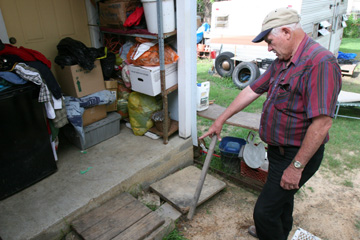 That was in early 2002. “I was told I’d have a house by August,” she said, but that didn’t happen. “First they lost all my paperwork, and I had to start the whole process over again. Then there was a big turnover in [department personnel] and I got all new people assigned to my case. They had to start over from scratch. Then the city had this big audit, and I was told there wasn’t enough money to start my house, so everything was put on hold again.” Three years after her house burned, she said, the construction finally started. Walker said housing department officials told her that the job of rebuilding her house would be put out for bid, and she would be allowed to choose her contractor from those who submitted proposals, but she never saw any bids. “All of a sudden, I was told [by the department] that the job would be done by City Construction Company, and I’d never heard of them,” she said. “That’s when I met Donald Cager,” the construction manager for CCC and the man she said oversaw the construction of her home, along with his assistant Wayne Harper. “I was told I had no choice over the contractor.” Her garage had not been damaged by the fire, and she asked that it be left standing — “but Cager said no, it had to go, and they bulldozed it down.”
That was in early 2002. “I was told I’d have a house by August,” she said, but that didn’t happen. “First they lost all my paperwork, and I had to start the whole process over again. Then there was a big turnover in [department personnel] and I got all new people assigned to my case. They had to start over from scratch. Then the city had this big audit, and I was told there wasn’t enough money to start my house, so everything was put on hold again.” Three years after her house burned, she said, the construction finally started. Walker said housing department officials told her that the job of rebuilding her house would be put out for bid, and she would be allowed to choose her contractor from those who submitted proposals, but she never saw any bids. “All of a sudden, I was told [by the department] that the job would be done by City Construction Company, and I’d never heard of them,” she said. “That’s when I met Donald Cager,” the construction manager for CCC and the man she said oversaw the construction of her home, along with his assistant Wayne Harper. “I was told I had no choice over the contractor.” Her garage had not been damaged by the fire, and she asked that it be left standing — “but Cager said no, it had to go, and they bulldozed it down.”
Cager did not return phone calls for this story. By the spring of 2005, Ruby Walker was in her new home — but not the home she’d been promised. She’d been led to expect that it would be larger, with a bath and a half and an attached garage, all clad in aluminum siding for easy maintenance, with handicapped-access ramps and railings. Walker suffers from several medical conditions, including arthritis, osteoporosis, and bad knees; her back is bent and misshapen. She walks with great difficulty now and figures she will eventually be confined to a wheelchair. For all those reasons, the handicap features were important. The house that she got came with hardboard siding, one bath, a small front porch, a very small living and eating area, two small bedrooms, a back porch with no steps, high thresholds at the front and back doors that are not wheelchair accessible — and no garage. “They told me they ran out of money and couldn’t build the garage — that if I wanted one, I’d have to build it myself,” she said. As it was, the house that the city company did build hasn’t lived up to even her lowered expectations.
Her backyard, which never used to flood, now does so after every rain, she said, because of poor grading. Workers only minimally cleared the debris from the burned home, Walker said, leaving so much broken glass behind that, almost six years after the fire, she’s still picking it out of her yard. Wide cracks run across the driveway and sidewalk. The concrete foundation was obviously patched and in places is crumbling. Inside, a bathroom wall is bowed, almost certainly from moisture, and there’s no caulking around the tub. Trim on lower kitchen cabinets is falling off. There is a ramp with a handrail leading from the back door to the driveway, but no ramp or steps from her porch to the backyard. A few months ago Walker sprained her ankle and injured her knees when she tried to step off the porch and fell. “We told them they needed to fix that step-off on the back porch or Mom might fall, and she did,” her daughter Pam Green said. Each time Walker or Green complained to the city about her house’s problems, they said, they were given the brush-off. “We were treated like we didn’t have any sense,” Green said. “I think they thought I was old and would die soon, so they didn’t have to pay any attention to me,” Walker said. Bill Clark, the state-licensed independent housing inspector and HUD consultant hired by the Weekly, did pay attention to Walker — and even more to the conditions he witnessed in a detailed three-hour check of the May Street house.
The owner of A-Z Inspection Service said he found “numerous areas of concern,” which he documented in a report. And, to add insult to injury, Clark found that the Tarrant Appraisal District’s deDELETEion of the house is wildly off — it’s about 930 square feet, rather than the 1600-square-foot house that Walker’s tax bills are based on. And it’s appraised at $130,000, though it cost less than $70,000 to build. “They need to come out here and look at it,” Walker said. Her little house, she said, “would never sell for anything close to that.” Clark found that the electrical wiring in Walker’s house was safe and done to code, that the house was structurally sound, and that the heating and air-conditioning system was properly installed. But the list of problems he found was much longer. The inspector found cosmetic problems such as peeling outside paint and loose siding that shouldn’t be happening in such a new house, he said, and he noted that soil is washing away as water runs off the unguttered roof onto the backyard that was not graded or filled properly. He also discovered even more serious deficiencies. “The foundation has obviously been patched, all the way around the house,” he said. He thinks that may have been necessary because workers pulled the forming boards off the concrete before it was completely dry, allowing it to sag and causing large cracks that required patching.
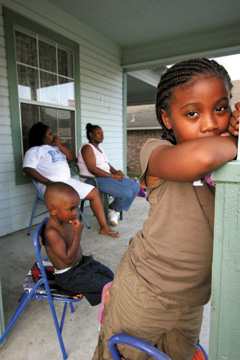 As for the driveway, Clark said Walker may have good reason to suspect, as she told city workers repeatedly, that it was built without rebar. The driveway “shouldn’t be cracking all the way across like this, this soon after construction,” he said. “These are not hairline cracks, they are large. What this tells me is there’s nothing to support the concrete. Either there’s no rebar or the rebar was installed improperly and sunk into the sand before the concrete was poured.” The high thresholds at the front and back doors and absence of steps or a ramp from the back porch to the yard “is not normal construction practice and doesn’t meet [federal] disability standards,” he said. “She would never get a wheelchair over that threshold, and I don’t understand how [the contractor] expected her or anyone to get to her backyard from the back porch.” The drop from the back porch to the yard is about a foot, he said, although the construction code requires that there be “eight inches from the top of the landing to the first step.” Walker’s two tiny bedrooms have one window each, on the west and east walls, but none looking out the south side of the house onto her driveway. That’s not a code violation, Clark said, but good construction practices call for more windows, especially on the south side, for cross ventilation, he said. The house’s compressed wood siding is “very, very thin, less than one-quarter inch” the inspector said, and susceptible to water seepage that could cause the panels to loosen, as some have already done.
As for the driveway, Clark said Walker may have good reason to suspect, as she told city workers repeatedly, that it was built without rebar. The driveway “shouldn’t be cracking all the way across like this, this soon after construction,” he said. “These are not hairline cracks, they are large. What this tells me is there’s nothing to support the concrete. Either there’s no rebar or the rebar was installed improperly and sunk into the sand before the concrete was poured.” The high thresholds at the front and back doors and absence of steps or a ramp from the back porch to the yard “is not normal construction practice and doesn’t meet [federal] disability standards,” he said. “She would never get a wheelchair over that threshold, and I don’t understand how [the contractor] expected her or anyone to get to her backyard from the back porch.” The drop from the back porch to the yard is about a foot, he said, although the construction code requires that there be “eight inches from the top of the landing to the first step.” Walker’s two tiny bedrooms have one window each, on the west and east walls, but none looking out the south side of the house onto her driveway. That’s not a code violation, Clark said, but good construction practices call for more windows, especially on the south side, for cross ventilation, he said. The house’s compressed wood siding is “very, very thin, less than one-quarter inch” the inspector said, and susceptible to water seepage that could cause the panels to loosen, as some have already done.
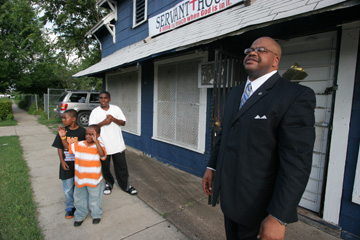 “It’s pretty cheap siding,” he said. He also found that the covers on the roof vents were not sealed to prevent leaks, a violation of city code requirements. But the most serious, and least excusable problem, he said, is the roof itself. “The prefab asphalt shingles on this house are all loose,” he said. The first row of shingles — called the starter course — was not installed in accord with the manufacturer’s instructions, affecting the entire roof. “They are not fastened down properly. … I can take my finger and lift them up. All it will take is a good high wind, and she’s going to lose her shingles. “What the contractor did or better yet, didn’t do, on this roof is a clear violation of the city code as well as the manufacturer’s installation instructions,” the inspector said. “And the person who may have to pay the price for this bad construction will be Mrs. Walker.” Clark warned that, if Walker loses shingles to hail or high wind, her insurance company could refuse to pay for repairs because the faulty installation could mean the shingle manufacturer’s warranty is nullified — a potentially heavy blow for someone who lives on $800 a month in Social Security benefits. There’s no excuse for the sloppy roofing, he said.
“It’s pretty cheap siding,” he said. He also found that the covers on the roof vents were not sealed to prevent leaks, a violation of city code requirements. But the most serious, and least excusable problem, he said, is the roof itself. “The prefab asphalt shingles on this house are all loose,” he said. The first row of shingles — called the starter course — was not installed in accord with the manufacturer’s instructions, affecting the entire roof. “They are not fastened down properly. … I can take my finger and lift them up. All it will take is a good high wind, and she’s going to lose her shingles. “What the contractor did or better yet, didn’t do, on this roof is a clear violation of the city code as well as the manufacturer’s installation instructions,” the inspector said. “And the person who may have to pay the price for this bad construction will be Mrs. Walker.” Clark warned that, if Walker loses shingles to hail or high wind, her insurance company could refuse to pay for repairs because the faulty installation could mean the shingle manufacturer’s warranty is nullified — a potentially heavy blow for someone who lives on $800 a month in Social Security benefits. There’s no excuse for the sloppy roofing, he said.
“Even if the roofer didn’t know how to install these shingles, each bundle has clear instructions in both English and Spanish, and if that’s not enough, there’s a step by step picture of how to do it right,” he said. “And of course the city, of all people, should follow the code.” A few doors down from Ruby Walker, Lydia Gonzalez lives with her cat in the 1930s-era house that her family called home for more than 20 years; Lydia inherited it last year when her mother, Ramona Gonzalez, died. About seven years ago, her mother got a HUD-funded $29,000 loan from the Housing Finance Corp. for remodeling work. The loan was to be forgiven if Ramona or some member of her family stayed there for 10 years after the work was done. “They were going to repaint inside and out, shore up the foundation, re-do the plumbing, and put in linoleum and new cabinets in the kitchen,” Gonzalez said. The idea “was to make this neighborhood better.” But except for the cabinets, the results were disappointing, she said. “It was painted in and out with cheap paint that didn’t last,” she said. The roof was redone, but when shingles came off over the kitchen, she called the city, and “nothing was ever done.” The kitchen linoleum is peeling.
There are stair-step cracks across the living room inside walls and the ceilings in the living room and kitchen. There are also cracks around the entire fireplace opening. “I’m worried about this foundation, with all the inside cracks,” she said. Work done in the bathroom was supposed to replace some rotting wood under the tub; the wood was not replaced, and the plumbing continued to leak. Her brother wound up re-doing the entire bathroom. “This has been a big disappointment,” she said. “I don’t think we got what we were promised.” On Stella Street in the Near Southeast neighborhood, John McCoy watched sub-contractors hired by the Housing Finance Corp. “throw up” a new house in 2001 — and said they put no insulation in the walls. That may be why Ronica Guy, who lives there now with her family under the Section 8 rental program, says the air conditioning doesn’t cool the house as well as she could hope. The paint “is not good quality,” she said, making it hard to keep the walls clean. Rayvonne Price is satisfied with the living area of her brick, three-bedroom, bath-and-a-half home on Truman Drive, on the city’s far Southeast Side, built for $73,000 in 1999 by the Fort Worth Housing Finance Corp.
But she’s not happy with the plumbing. “I’ve had leaking plumbing ever since we came here,” she said. “Just about every time I wash clothes, I have water back up around the washer. … It’s a real problem.” Price bought her home with a HUD loan that was forgiven after she had lived there five years. In far North Fort Worth, on one of the city’s highest points, the house at 3212 Prairie St. has been vacant for several years. The owner, unable to sell it, has let the yard grow tall with weeds — a problem for the modest surrounding neighborhood. The owner in this case is the city, and the structure is another testament to the city’s deficiencies as a builder of low-income housing. The house was built in 2001 for an older couple, Sam and Martha Gray, by the Housing Finance Corp. But, according to former housing department workers who asked not to be identified, when the house was finished, the couple found it was so poorly built, with so many problems, that they refused to accept the deed until corrections were made. Sam Gray died shortly after he and his wife moved in. The city foreclosed, his widow was evicted, and the house was put on the market — where it has stayed. In Stop Six, there are several blocks where the city-owned houses can be identified by boarded-up windows and city-owned lots by the tall weeds and brush.
The deteriorating house at 5405 Cottey St., for instance, has been owned by the city since 2003. And out on Eastcrest Court, in the same neighborhood, only two of the six new brick houses built by the City Construction Company in 2005 have sold, according to Jerome Walker. The sale prices range between $110,000 and $130,000. Walker said the more upscale housing development was put in the mostly low-income area to encourage private developers to build affordable housing there. So far there are few takers, either for the houses or the hoped-for developers. The entity that built the Price house and the Grays’ house and that renovated the Gonzalez home is one that’s little-known to most in Fort Worth but that has a strong effect — and not always positive — in the city’s poorer neighborhoods. The Fort Worth Housing Finance Corp. was created in 1979 to promote housing in marginal inner-city neighborhoods, but has since morphed into a real estate company that buys and sells all over town, makes loans to developers, and runs a land bank and its own construction company — CCC, which built Ruby Walker’s home as well as the houses on Eastcrest.
The city council acts as the Housing Finance Corp.’s board of directors, and its once-a-month meetings usually last no more than a few minutes. Former council member Donavan Wheatfall said that, in recent years, the city council has provided no oversight of the finance corporation, of the CCC, or the housing department in general. “The council is the board, and it just rubberstamps anything Jerome brings to it,” he said. That leaves the only oversight of the city’s housing department to HUD, whose monitoring reports on the way the city spends federal dollars can sometimes take years to complete. For example, HUD recently forced the city to set aside $1.45 million that may have to be used to pay back federal funds misspent between 1999 and 2004. The figure is based on a 2003 HUD audit that found discrepancies in the way the city housing department had accounted for federal dollars on projects such as the Mercado commercial development on the North Side and the Evans-Rosedale redevelopment project on the East Side. Both projects have cost millions, and neither has delivered the promised commercial and residential redevelopment of the surrounding low-income areas. To date, Evans-Rosedale is still a mostly blighted area.
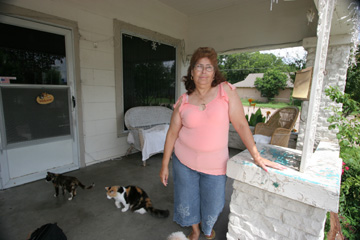 The Mercado was sold at a huge loss to a private developer. And now, two recently released HUD reviews of the city housing department have exposed “serious deficiencies” in the administration of its affordable housing programs and other federally funded programs for the poor and low-income, including a “substantial amount of questionable costs” and home repair deficiencies noted by HUD that the city’s inspectors did not find. HUD officials also found that the housing department staff was not properly trained to detect the presence of lead during house paint tests. Because the city’s inspections were so deficient, HUD is requiring the housing department to “re-inspect all pre-1978 existing units” that were renovated with federal funds by the city or its contractors from 2005 to the present and make repairs where needed. According to the report, the city will have to reimburse hundreds of thousands of dollars to HUD’s HOME program from “nonfederal funds” — i.e., local tax dollars — because of housing projects, jump-started with federal funds, that are now being foreclosed on by banks. They include the Victory Arts apartments on Hemphill Street ($287,000), Women’s Second Chance transitional housing project ($61,000), and the Rolling Hills/Glen Eden housing development off Riverside Drive ($253,628.)
The Mercado was sold at a huge loss to a private developer. And now, two recently released HUD reviews of the city housing department have exposed “serious deficiencies” in the administration of its affordable housing programs and other federally funded programs for the poor and low-income, including a “substantial amount of questionable costs” and home repair deficiencies noted by HUD that the city’s inspectors did not find. HUD officials also found that the housing department staff was not properly trained to detect the presence of lead during house paint tests. Because the city’s inspections were so deficient, HUD is requiring the housing department to “re-inspect all pre-1978 existing units” that were renovated with federal funds by the city or its contractors from 2005 to the present and make repairs where needed. According to the report, the city will have to reimburse hundreds of thousands of dollars to HUD’s HOME program from “nonfederal funds” — i.e., local tax dollars — because of housing projects, jump-started with federal funds, that are now being foreclosed on by banks. They include the Victory Arts apartments on Hemphill Street ($287,000), Women’s Second Chance transitional housing project ($61,000), and the Rolling Hills/Glen Eden housing development off Riverside Drive ($253,628.)
The city housing department was also cited in the reports for failing to diligently oversee its contractors, failing to keep proper accounting records, and failing to follow HUD rules regarding the use of government funds that passed through its coffers from 1992 to 2006. The HUD reviews also found a substantial amount of money allocated but not spent, in spite of the growing need during the past decade for housing for the poor. From 1996 to 2005, the city received HOME allocations to build low-income affordable housing totaling more than $41.3 million but spent only about $29.6 million — an outcome that HUD calls “unacceptable.” HUD officials reported that the city had failed to spend more than $1 million from prior fiscal years intended for local nonprofit housing development groups. There’s another nearly half a million that the city has failed to disburse to those groups since 2002. The report also said that two nonprofits the city has been dealing with do not meet HUD guidelines — and the city not only has been ordered to immediately cease funding those two organizations but will also be required to pay back the money already granted to them.
Fixing the problems won’t be easy. Katie S. Worsham, community planning and development director for HUD’s Fort Worth office, said in a cover letter to City Manager Charles Boswell that the city housing department “must change the business practices currently being employed.” On Glen Eden Drive, in the Glen Garden area just off South Riverside Drive, another failed promise is visible in acres of empty, treeless lots with curbs and gutters and utility lines ready to be attached to houses that never materialized. The city invested $274,000 from HUD’s HOME program in 2002 to pay for infrastructure — such as streets and utility lines — to jump-start a planned 55-home development that got no further than construction of two model homes. It was the brainchild of developer Leonard Briscoe acting as an agent for the Rev. Nehemiah Davis’ church-based nonprofit, Texas Housing Economics and Resources, which has filed for bankruptcy. The case is now in court Chase Bank, which loaned THER $2.72 million for the project, is trying to foreclose, according to court records.
City attorneys, arguing against the action, told a federal judge that if the bank forecloses, Fort Worth will have to repay the full $274,000 to HUD out of the city’s general fund. In spite of the impending foreclosure and HUD’s demands for repayment from the city, Jerome Walker told the Weekly several weeks ago, “I still believe in the Briscoe project, and have confidence that the city will be repaid.” The city isn’t the only public entity to take a hit. Court records show that one board member of THER is Fort Worth school district trustee T. A. Sims. The documents also show that THER owes the district $7,000 in back taxes. The city housing department, it seems, has had as spotty a record in choosing developers to partner with as it has building and repairing homes on its own. A few miles northeast of the Glen Garden area, the unsold homes on Eastcrest Court sit across the street from the Villas of Eastwood Terrace, another project financed by the city’s Housing Finance Corp. with HUD money. But that project, a gated senior-citizen apartment community, is almost entirely occupied, with one-fourth of the units rented at market rates, and the rest reserved for low-income seniors. Not far away is another joint project of HUD and the city’s housing finance corporation: a Minyard’s store at Miller Avenue and Berry Street that has attracted a couple of other businesses to that corner but has not spurred economic development of the surrounding area as was touted by the city when the grocery store opened five years ago.
While other areas of Fort Worth have blossomed — some would say, exploded — with the impetus of a healthy economy and growing population, the city’s poorest neighborhoods have stood stagnant or gotten worse, with high rates of unemployment, infant mortality, dropouts, and a plethora of boarded-up houses and vacant lots. Housing is only one part of that grim picture — but Eastside leaders like Wheatfall and the Rev. Kyev Tatum say it’s a part that’s indicative of a broader attitude toward their part of town. Tatum and Wheatfall blame the mayor and council majority, who, they said, have given only lip service to the plight of the city’s growing ranks of poor families. Drive through any of those neighborhoods, Tatum said, “and you will see Third-World poverty conditions. It is obvious that no money is being spent to make these communities livable. Trash is left on the streets, vacant lots are waist-high in weeds, houses are falling apart, parks are nonexistent or so neglected it’s not safe for kids to play in them.
There are no close, convenient libraries or community centers, and new housing, if it exists, is scatter-shot and shoddy, sitting next door to abandoned, boarded-up houses filled with rats. … You tell me, how long would such conditions be allowed to exist on the West Side?” Those kinds of conditions, he said, make a mockery of the “most livable city” title of which Fort Worth is so proud. All of the millions that the housing department has misspent — in building low-quality houses, doing slipshod repair work, giving out grants for work never done, and investing in projects that haven’t lived up to their potential — could have been spent for decent housing for the poor, had there been adequate oversight, Tatum said. And the worst part, he said, “is that no heads will roll for this mess. It’s called ‘the Fort Worth Way.’ The big boys protecting their own.” Doing low-cost housing well isn’t impossible: Since 1999, Habitat for Humanity has received city funding every year to do just that, and has used the grants to purchase 76 lots from the city. Gage Yager, executive director of Trinity Habitat for Humanity, estimated that 95 to 99 percent of those lots now have homes on them — houses that, from the exterior at least, look much sturdier and better built than those done by the city.
Other community-based housing nonprofits have also successfully built and rehabilitated homes in poor neighborhoods — though the leaders of a number of those groups say they’ve done it in spite of, rather than with the cooperation of, the housing department. There is no question that the need for housing for low-income folks here is at a crisis point, said council member Kathleen Hicks, who represents District 8, an inner-city area with a predominantly minority population and one of the highest concentrations of poor residents in the city. There are more than 800 vacant lots in her district, she said, that could be filled with quality, affordable housing if the city would make the commitment. For the last year she has served as chair of the housing finance corporation board, but said that she has “no hands-on” involvement with its building practices or those of the city construction company. She said she has not read the latest HUD reports and can’t comment on them. In the interview last month, Jerome Walker talked about the successes of his department. Since 1999, through the housing finance corporation, he said, the city has sponsored the construction of more than 100 new homes and has built apartments for senior citizens. But no one from the housing department would directly answer follow-up questions over the past two weeks. Lamers, from the city’s public relations office, said that all of the homes built or renovated by city crews met building codes and were properly inspected. He blamed the recent rains for high weeds on city-owned lots. And the HUD criticisms, he said, were nothing more than “regulatory compliance issues.”
You can reach Betty Brink at bettybrink@att.net.











